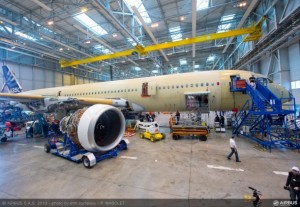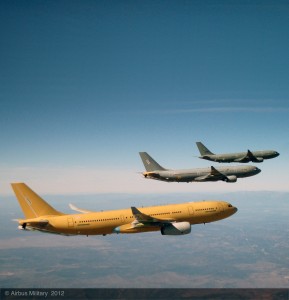By Robbin Laird
The Paris Air Show occurs every other year and alternates with Farnbourgh as the major European Air Show.
As the world has changed, air shows have been altered as well, with regional air shows in India and the Middle East becoming more important to the vendors seeking sales in the evolving global market place.
The marketplace is a dynamic and fluid one, and not defined by the economic pessimism often seen in Washington and European capitals.
With sequestration, U.S. participation is clearly down at the PAS, and some major companies are not even there. But the US sequestrating itself is not a comment on the globe, simply on the United States. Self-withdrawing is not an option for ascendant powers world wide or for dynamic regions such as the Asia-Pacific region.
The dominant commercial story will be in the twin aisle market.
The Dreamliner will return after its bout with battery jitters and the A350 will be in the wings.
With the difficulties in delivering operational 787s, the A350 has closed the gap in terms of to market airplanes, by several years, probably around a three-year gap.
Although this matters in terms of company cash flows, in terms of the industry over all it does not. These two planes and their various variants will dominate the twin aisle market over the next 30 years. And the often much maligned A380 will recover space in the large aircraft market as well.

Those concurrently developed airplanes –the 787, the A380 and the A350 – will dominate global commercial aviation for decades to come. Remember the evils of concurrency, but the reality is that the commercial world dominates the military and much of the content for a new combat jet like the F-35 comes from developments in this world and development of new products such as the A400M and A300MRTT are stepchildren of that world.
As the CEO of EADS reminded critics:
It’s the unexpected that usually gets you. So we never underestimate the complexity of a whole new development like the A350. Believe me, I learned from my mistakes and the mistakes of my competitors. And you can never guarantee that you won’t have problems. The best way to avoid such problems is not to develop new aircraft.
The story is different with regard to single aisle aircraft and for regional jets.
Here the emergence of the “new” world of aviation is crucial. China, Brazil and Russia, to name three, are not only key players in the regional jet market but bumping up into the single aisle markets as well.
And global alliances are crucial in this market space as well. Airbus is opening a final assembly line in Mobile, and may well be laying the groundwork for doing its next generation single aisle very differently from the way it is doing it now. Boeing is doing a dance with Embraer with regard to the Super Tucano, and with regard to the F-18 in Brazil. Their are supporting the ST with weapons and are hoping to sell the F-18 to Brazil which may then see a Brazilian-built F-18 exported from Brazil. There is also the possibility of building a new single isle aircraft with Embraer as well.
The military aviation component is significant as well at Le Bourget but not as easy to analyze as the fate and future of the Boeing-Airbus commercial duopoly.
The military market is fluid in part because the global situation is as well. The future of manned aviation is solid with new aircraft coming on line, and the prospects for replacing legacy aircraft and building out fleets in the developing nations significant as well.
The show will feature many UAV contenders, but the UAVs themselves have to content with several key aspects shaping their future market and success.
UAVs are clearly part of the future of military aviation and not its future. With the end of large scale forces operating in Afghanistan, it will become clear that UAVs operated their within large infrastructures to support operations. It will come home to folks the fragility of UAV operations outside of the existence of a significant logistical footprint.
UAVs are the ultimate cyber target. They are really data links operating in airspace and very vulnerable to jamming and spoofing.
But the EuroHawk debacle is a key flash point to remind people of the contextual quality of unmanned systems. The recent decision by the German government to abandon its technically successful adaptation of the US global hawk is rooted in regulatory issues. This is a clear case of technology conflicting with regulatory management lag. It also suggests a broader consideration for the future of UAVs in European airspace.
According to senior German industrial source,
The German government is pulling the plug not because of the performance of the UAV, but because of the nature of the regulatory process. German MOD was planning to replace our older capabilities (already retired) with the Atlantique with the EuroHawk.
But to get the regulatory approval to fly in European airspace requires adding a sense and avoid capability that is not in the aircraft.
Indeed, the regulators have suggested a review process, which would require us to certify a variety of parts in the UAV beyond any normal safety requirements for the operation of the UAV itself.
Or put in other terms, the regulatory system is simply not ready for UAVs, and is using EuroHawk as the test case and we would have to pay a premium for their learning.
But clearly, robotics among which UAVs are a key example are crucial aspects of the future and part of a 21st century force.
As such, the evolution to watch is the ability of companies to build out interactive robotic and manned capabilities in the evolving force structure.
And combat aircraft will be featured as well, probably the flying star will be the Su-35.
It is important to get 35 in the title in order to make a Russian point. And hopefully, this plane does not repeat the experience of the SU-30 at the 1999 Paris Air Show, where spectators witnessed a dramatic crash.
http://www.ovguide.com/sukhoi-su-30-1999-paris-air-show-crash-9202a8c04000641f80000000201a3cb7
The Russians are in a struggle to maintain their position in their most central export market – India.
The continued demonstrated of the growth potential of the Sukhoi line is part of the meet the challenge effort to keep their stake in India and to build out.
The F-35 is flying in many hours and numbers currently, but will not be doing so at Paris, but clearly could do so.
As the USMC expects IOC of the F-35 in 2015, and the USAF in 2016, and the Navy in 2018 or 2019, the fleet is expanding to prepare for this process. Lt. General Schmidle, the Deputy Commandant of Aviation will attend the Air Show and discuss the USMC build out of the F-35B to join the fleet in 2015.
The USMC-USAF strategic alliance in launching their F-35s initially at Yuma and Hill AFB and then to the Pacific is built on the commonality within the aircraft. The software in both aircraft is the same, with the variants 2 and 3 simply built around different processors.
In many ways, the USMC’s other star aviation asset, the Osprey, is a key element shaping the future of 21st century aviation and will be at the PAS for sure. It has come to Europe in a significant way, as it is the backbone for a new Special Purpose MAGTF currently operating out of Spain and able to operate in Africa and the Mediterranean, and ready for Benghazi type events.

Another combat aircraft present – the Super Tucano – is the flagship of the important effort to shape an air power and combat transition in Afghanistan.
According to the NATO Air Training Command: the goal of the NATO air advisory team is to shape a “strong Afghan Air Force partner successfully assuring the present and future security of Afghanistan.”
A key piece of equipment in the plan is the acquisition of the Super Tucano for the Afghans.
Fortunately, Embraer is not following the idiotic rhythm of the destructive dynamic of sequestration whereby not showing up is supposed to make a point about economies rather than about the American global presence.
Having strong global partners rooted in dynamic economies is a key element of an effective US 21st century defense and security strategy.
Two other military aircraft are present at the show and marking the entry and growth of 21st century air systems.
The A400M is being delivered this summer to the French Air Force and the first FAF A400M will be seen on static display while an Airbus Military aircraft does the flying at the show. The ability of the A400M to carry C-17 type loads to the point of attack, as does the C-130 will be a significant game changer for the airlift market.
The other element of a global fleet built around Airbus Military aircraft is the A330MRTT.
The plane is built on the foundation of the very successful A330 commercial aircraft, which is used widely and globally. When the A330MRTT was built, Airbus Military went back and redesigned the plane around new computer based designed tools and a new and even more robust plane emerged crafted for the tanking mission. The capacity of the plane to be refueled itself – notably enhanced in some variants of the aircraft – can reinforce an important air base in the sky quality to a fleet of A330MRTTs.
Several planes have been delivered and are in operation with Australia, the UK, Saudi Arabia, the UAE and the Indians have down selected the Airbus tanker as well. Tanking has been a core US dominant capability, but with the aging of the fleet, the need for others to pick up the slack is obvious, and they are largely doing this with the A330MRTT.
In short, as always the PAS provides a moment to take stock of the global aviation market.
The commercial market is robust, and the military market is in its own way. These are both cyclical markets subject to the impact of outside events. And when one of those loose Libyan Manpads hits a commercial airliner, the cyclical nature of the commercial market will certainly be highlighted again.
For a look at the lift and tanking market as seen by Airbus Military see the following briefing:
For Boeing’s current commercial market forecast:
http://www.boeing.com/boeing/commercial/cmo/
For Airbus’s current commercial market forecast:
http://www.airbus.com/company/market/forecast/
For the Su-35 company marketing video see the following:
http://www.youtube.com/watch?v=QPShemnHPio
For an A400M formation flying video see the following:
For our series on the A380 and airplane manufacturing see the following:
https://sldinfo.com/a380-manufacturability-putting-concurrency-in-its-place/
https://sldinfo.com/a-retrospective-on-the-a380-the-naysaying-internet/
https://sldinfo.com/flying-on-the-a380-a-retrospective-on-making-a-new-airplane/
A version of this piece has recently appeared on Breaking Defense as well:

